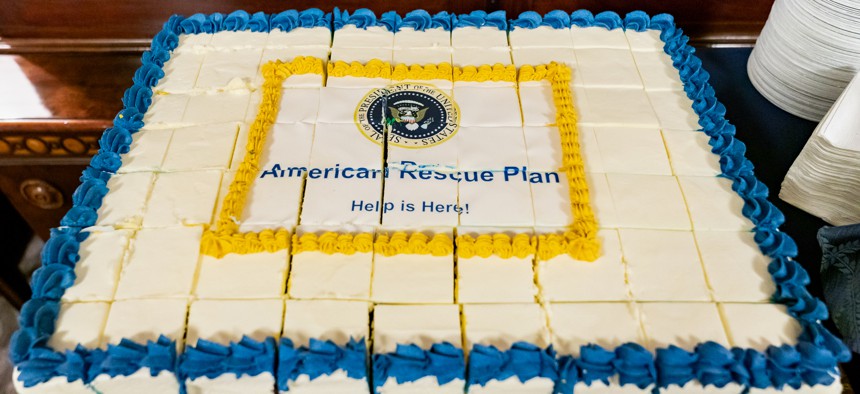
A cake is cut and ready to serve in the West Wing Lobby of the White House on Friday, March 12, 2021, to celebrate the signing of the American Rescue Plan. Official White House Photo by Carlos Fyfe
How to Maximize Nonprofit Impact with the American Rescue Plan
By engaging in effective decision-making and budgeting, organizations can provide services they know work, fix those that don’t and improve the relationship between funding and impact.
Currently, there are at least 1.4 million nonprofit, tax exempt organizations in the United States. These groups, including charities and foundations, spend nearly $2 trillion annually. If you stacked that much money in $100 bills, the pile would reach 1,262 miles into space.
Nonprofits now find themselves in a pivotal moment, thanks to an additional $2 trillion in funding from the American Rescue Plan. The ARP is a massive infusion of stimulus into new and existing federal programs, state and local governments, businesses, and households intended to accelerate the nation’s pandemic recovery. If spent wisely, it will do that and more, helping America fulfill the Biden administration’s ambition to “build back better.”
Nonprofits have played a critical role in pandemic response, and they will play an even larger role in the recovery. The government entities responsible for spending ARP dollars need nonprofits as partners to develop strategy, design programs, and deliver services. As tempting as it may be to see the ARP as easy money, nonprofits should take the long view, because ARP won’t last forever. This means striving to achieve the greatest impact with available funds. It means engaging in disciplined performance management and cross-sector collaboration to analyze the effect of strategies on population outcomes. By engaging in effective decision-making and budgeting, organizations can provide the services they know work, fix the ones that don’t, target funds appropriately, and improve the relationship between funding and impact.
In addition to the trillions for recovery, ARP also provides for extensive oversight of how the money is spent, and it won’t just be the watchdogs who want to see a return on investment. Everyone has a stake in the ARP’s success. To get nonprofits ready for the ARP spotlight, here are some tips on what I have learned establishing performance management and reporting systems for clients across the globe:
- Align with a larger common agenda. Having a set of recovery results and indicators or performance measures for the services that the ARP investment seeks to impact will help create a sense of purpose and serve as a North Star for action.
- Remember: Less is more. Fewer but more powerful measures that speak to impact are important. Avoid a laundry list of measures that aren’t useful for decision-making and planning.
- Disaggregate by race and gender. Start small by collecting and disaggregating data by race for at least one of the impact measures. Then, expand this effort once you have built up your disaggregation muscles. This will inform strategy, target resources towards those most affected, help ensure equity in your service delivery, and create greater impact for everyone combined.
- Be consistent and flexible. Establishing standard measures across like programs can help you compare the effectiveness of different investments. Data can also be aggregated to tell a comprehensive story of impact. Note: grantees should still be allowed to pick measures that are unique and useful to them. You can learn more about measuring performance and outcomes across funding streams here.
- Never report on data without the “story.” Data without the story is meaningless. The story consists of contributing and limiting factors that determine the context behind the data. Make sure all pieces of reported data have accompanying analysis of the trend and a series of actions for improvements over a specified time period.
- Use the data and corresponding analysis for meaningful dialogue. Program and grant leaders will not just think it is a paper exercise if the data, story, and plan are the basis for a regular conversation with their bosses or funders.
- Share the performance reports publicly. Both the funder and grantee should share the reports on their websites. Transparency creates trust and trust leads to more funding.
By implementing these tips in your performance reporting system, you will develop better data to share with leadership, funders, donors, and other stakeholders. If you have grantees, they will have put more thought into their performance and improvement plans, and they will build their capacity to demonstrate impact and attract more funding. Ultimately, and throughout every industry, data-based decision making and funding will help us all get the best possible results from ARP dollars and achieve better outcomes beyond ARP for the children, families and communities we collectively serve.
Adam Luecking is CEO of Clear Impact, a public sector performance management technology company based in Rockville, MD. His email address is adam@clearimpact.com.






